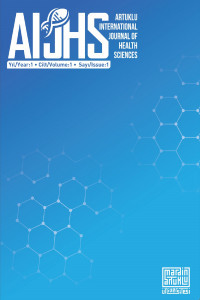Maksillofasiyal Travma ve Zor Havayolu Yönetimi: İki Olgu Sunumu
Maksillofasiyal yaralanmalar, Hava yolu yönetimi, Travma
Maxillofacial Trauma and Difficult Airway Management: Two Case Reports
Maxillofacial injuries, Airway management, Trauma,
___
- Kovacs G, Sowers N. Airway management in trauma. EmergMedClin N Am.2018;36:61–84.
- Hutchison I, Lawlor M, Skinner D. ABC of major trauma. Major maxillofacial injuries. BMJ. 1990;301:595-99.
- Patel A, Saadi R, Lightall JG. Securing the airway in maxillofacial trauma patients: A systematic review of techniques. CraniomaxillofacialTrauma&Reconstruction. 2021;14(2):100-109.
- Kazak Z. Anesthetic Management of patients with maxillofasial trauma.Turkiye Klinikleri J AnestReanim-Special 90 Topics. 2008;1(3).
- Domino KB, Posner KL, Caplan RA, Cheney FW. Airway injury during anesthesia: A closed claims analysis. Anesthesiology. 1999;91:1703–11.
- Schmidt UH, Kumwilaisak K, Bittner E, George E, Hess D. Effects of supervision by attending anesthesiologists on complications of emergency tracheal intubation. Anesthesiology. 2008;109:973-977.
- Peterson GN, Domino KB, Caplan RA, Posner KL, Lee LA, Cheney FW. Management of the difficultairway: A closed claims analysis. Anesthesiology. 2005;103:33-39.
- Brown CVR, Inaba K, Shatz DV, et al. Traumasurg. Acute Care Open. 2020;5:e000539. doi:10.1136/tsaco-2020-000539
- Lewis SR, Butler AR, Parker J, Cook TM, Schofield-Robinson OJ, Smith AF. Videolaryngoscopy versus direct laryngoscopy for adult patients requiring tracheal intubation: A cochrane systematic review. Br J Anaesth. 2017;119:369–83.
- Rabitsch W, Schellongowski P, Staudinger T, Hofbauer R, DufekV,Eder B, et al. Comparison of a conventional tracheal airway with the combitube in an urban emergency medical services system run by physicians. Resuscitation. 2003;57:27-32.
- Helm M, Gries A, Mutzbauer T.Surgical approach in difficult airway management. Best PractResClinAnaesthesiol. 2005;19:623-640.
- Dob DP, McLure HA, Soni N.Failed intubation and emergency percutaneous tracheostomy. Anaesthesia. 1998;53:72-74.
- Başlangıç: 2021
- Yayıncı: Mardin Artuklu Üniversitesi
Maksillofasiyal Travma ve Zor Havayolu Yönetimi: İki Olgu Sunumu
Enes ÇELİK, Mustafa BIÇAK, Hakan AKELMA
Bir Üniversite Hastanesinde Sözel İstem Alma Süreci, Kontrolü ve Sonuçlarının Değerlendirilmesi
Tuğba MERT, Yasemen ÖZKAN, Muhsine ARSLAN, Aynur YÜCEL
Yağmur YILMAZ, Birgül KANDEMİR, Şeymanur GÖKÇE, Tuğba ERGÜL, Mahmut DAĞCI
Medulla Spinalis Yaralanmalarında Nörorejen İskele Uygulamaları
Ulipristal Asetatın Ratlarda Oluşturulan Cerrahi Endometriozise Etkisi
Mehmet Nuri DURAN, Hacı Öztürk ŞAHİN, Nihal KILINÇ, Bülent DEMİR
Diminutif ve Küçük Kolorektal Poliplerde Kanser Riskinin Değerlendirilmesi
Serhat GÜNLÜ, Mehmet Zülkif KARAHAN
Üçüncü Basamak Bir Hastanede Dermatolojik Acil Durumlar: Tanımlayıcı Bir Çalışma
Dilber ÜÇÖZ KOCAŞABAN, Mehmet Serkan YURDAKUL, Figen COŞKUN
